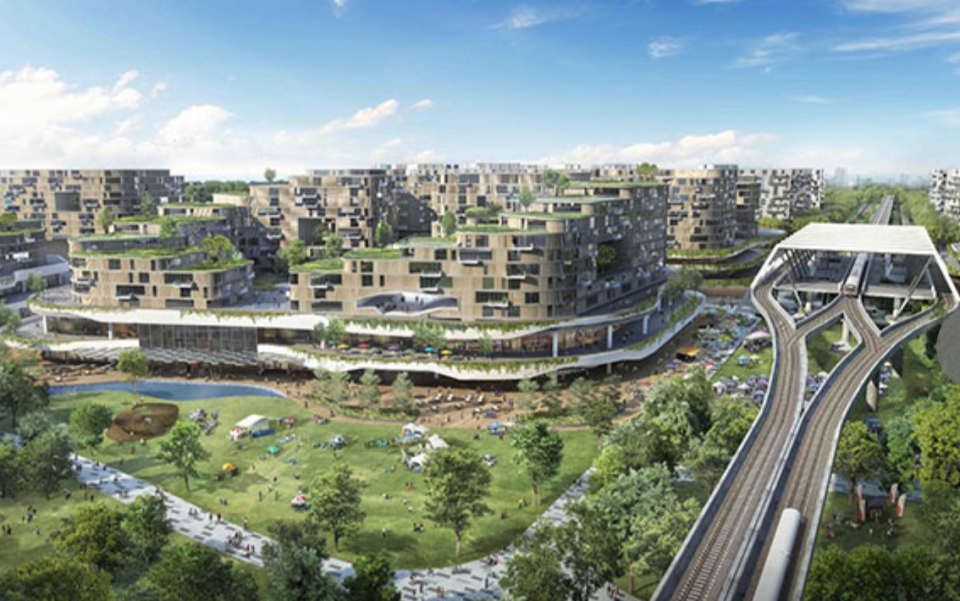Singapore’s new city of the future is its greenest project yet

By Faris Mokhtar
(Bloomberg) -- Giant solar-powered air-conditioners, vacuum garbage collection, subterranean roads for electric vehicles, urban farms and green architecture. Put them all together and you have Tengah, Singapore’s most ambitious project yet to build the city of the future.
Tengah, which means ‘centre’ in the local Malay language, is part of Singapore’s effort to reduce a carbon footprint that’s bigger than some countries that are 50 times its size, and to promote sustainability in energy, water and waste. The Southeast Asian nation, which is smaller than New York City, has set a target of capping its emissions by around 2030 and then halving them by 2050.
Key to reaching that goal will be to tackle the city’s debilitating tropical heat and humidity, while cutting the nation’s ever-rising energy bill for air-conditioning.
Once described by founding prime minister Lee Kuan Yew as the greatest invention of the 20th century, air-con is now widespread in homes and offices. The nation has more cooling units per capita than anywhere else in Southeast Asia. With tropical temperatures averaging around 27 Celsius (81 Fahrenheit) year-round and rising, the amount of power needed to cool Singapore is projected to grow 73% between 2010 and 2030, according to local research.
To slow the increase, the new town will use a district cooling network based on a commercial system in Singapore’s Marina Bay Financial District, where refrigeration plants and pipes were laid underground before the offices were built.
In Tengah, the cooling units will be solar powered and installed on rooftops of public-housing blocks, with chilled water piped through the buildings. The system’s operator, SP Group, says the network can cut energy use by 30% -- an emissions saving equivalent to 4,500 gasoline-powered cars. Residents have the option of connecting to the centralised cooling, or buying and running their own traditional air-con units.
“The biggest challenge that we face is to get residents to sign up,” said S Harsha, Singapore managing director of sustainable energy solutions at SP Group. The key is to show residents how the energy-efficient system can save them money, he said.
Since the government’s Housing and Development Board began offering 8,000 flats in the new estate in 2018, close to 1,000 buyers have signed up for the centralised cooling, which Harsha said would be cheaper to install than a normal system. Homes in Singapore’s new public housing projects are sold at a subsidised price to citizens -- mostly young married couples -- based on a ballot before construction begins. The first batch of Tengah’s planned 42,000 flats will be ready by late 2022 or in 2023.
Young couple Shaun Wong and Beverly Tan said it was the project’s green credentials that made them decide to apply for one of the homes.
“We’re merely perpetuating a practice that we’ve adopted,” said 23-year-old Tan, who runs an e-commerce business and said she favours eco-friendly clothes and household products and prefers to use a fan rather than air-con. “Practice what you preach.”
Once the site of brickworks and pepper plantations, the new town will have five districts with community farming, garden and forest themes. A 100 meter-wide, 5 kilometre-long corridor of trees will run through the district, connecting it with the island’s central nature reserve.
Singapore Prepares for a Far Hotter World Than Experts Predicted
Each of the 42,000 government-built apartments will have a ‘smart’ dashboard that allows homeowners to monitor energy consumption.
The energy monitoring app for Tengah residents.
Rail networks, access roads and car parks will mostly be below ground, freeing space for gardens, urban farming and for walking and cycling. Singapore is turning its attention to electric vehicles following Hyundai Motor Group’s investment in a new innovation centre that may produce up to 30,000 vehicles a year by 2025. Charging stations will be installed in the new town’s car parks.
Smart Design
The HDB used 3-D environmental modelling software to create the blueprint for Tengah, simulating the effects of changes in wind, temperature and sunlight on buildings and their surroundings. The aim was to find the best way to design and orientate buildings, vegetation, water and open spaces to promote shade and natural ventilation and mitigate the urban heat-island effect.
An automatic pneumatic waste conveyance system will collect trash through underground pipes. “It helps create a cleaner and more hygienic living environment by reducing odor and spillages associated with manual collection, and minimising pest infestation,” the HDB said on its website.
SP Group is developing a waste management system that will turn the garbage into energy using a gasification plant -- a more efficient way of producing fuel than an incinerator.
The overall effect of the project is to move Singapore forward in its search for a truly green city, said Lahiru Wijedasa, co-principal investigator and senior research fellow at the National University of Singapore’s Environmental Research Institute.
“This is definitely a step in the right direction,” he said, especially the efforts to aid cooling. “Developments like this, in addition to efficient design of amenities, will have a far greater effect on reducing long-term carbon footprint than the actual greenery. Future developments will continue to push the boundary, and eventually our journey will lead to the most environmentally sustainable city possible at that particular time.”
© 2020 Bloomberg L.P.

 Yahoo Finance
Yahoo Finance 